
Kettle Run 4/25
Quote of the day: "As I would not be a slave, so I would not be a master. This expresses my idea of democracy. " --Abraham Lincoln
These tests were done on April 25, 2011. The camera was my Panasonic G1 purchased in Decmeber, 2010. The camera was mounted on a Gitzo 1541 carbon fiber tripod with an Acratech ballhead. The shutter was triggered using a Panasonic wired remote shutter release. The weather conditions were a mix of sun and clouds and some wind. I was concerned about the amount of wind, since it did seem to be buffetting the camera a bit--therefore I tried to wait for periods of relative calm before making exposures. Also, the shutter speeds were quite high for the larger apertures (1/3200 @ f2) so the effect of the wind should be insignificant for the larger apertures. Due to the clouds, individual areas of the images may be dark or light depending on the position of the clouds. I attempted to make sure the buildings in the distance were not in shadow, although there may be some variation in lighting. Since the purpose of the tests was to determine the sharpness and contrast of the lenses at various apertures, the varied lighting conditions were not deemed a hindrance (as they would be if vignetting was being measured--not an issue with full frame lenses on a 4/3 sensor camera). The buildings in the distance were approximately 1/4 mile from the camera position. All lenses were focused manually using the G1 LCD magnification feature. All lenses were focused at the maximum aperture (wide open) and the focus was not adjusted as the lens was stopped down.
The images were postprocessed from RAW files using the AdobeRGB color space. No sharpening has been applied to the crops. The files were converted to the sRGB color space when they were converted from TIFF to JPEG. A Fotodiox lens adapter was used to mount the lenses on the Panasonic G1. This adapter is well made and the lenses fit snugly with no play. However, all the tested lenses focused past infinity, which may be a design choice by Fotodiox to make sure all possible Minolta MF mount lenses (including those make by third-party manufacturers) can achieve infinity focus.
Note: Sample variation is always an issue when testing lenses. A single lens may not be indicative of the average lens performance. The lenses I am testing are my own, for the purpose of determining whether they are worth keeping in my photo backpack. Your lens may be different...
This lens has been in my collection from the late 1980's. I purchased it new and it is in excellent condition. I take very good care of my equipment and to my knowledge this lens has never been abused. I have read on the Internet that this lens is not a stellar performer and my the images below confirm this. The lens is not particularly sharp, even in the center. Stopping down does not improve sharpness much in the center, but does make more of an improvement at the edge. Contrast is not terrible wide open, and improves slightly when stopped down to f4--after that there is little improvement. This lens is nice and small and, as usual for Minolta manual focus lenses, has a very nice focusing action. However, based on these tests I will probably not bother carrying it in my bag. I already have the focal length covered with the Panasonic 14-45mm zoom and the only benefit of the Minolta 28mm is the larger aperture, but I'm really only gaining 1 stop if I shoot the Minolta at f4 as opposed to the Panasonic at f5.6 (which performs pretty well wide open--see below).
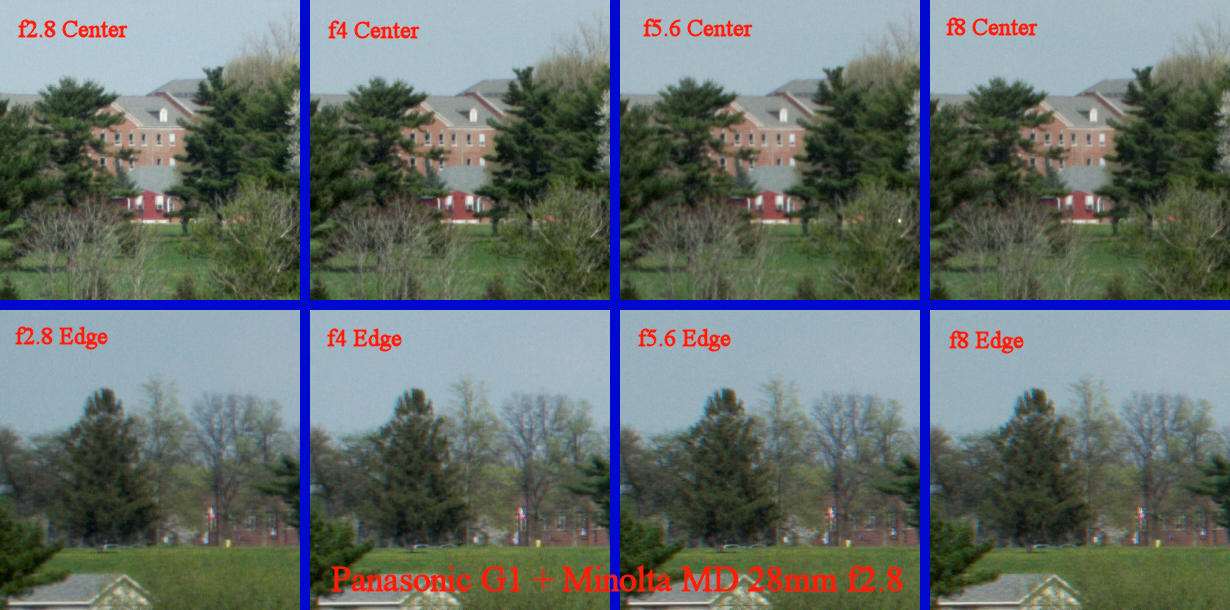
I purchased this lens used in 2009 prior to a photo trip to Maine. On previous trips I encountered problems with creating panoramas from multiple images when the camera was not perfectly level. The distortion in wide angle lenses can cause issues if the camera is not level with the horizon. The problem with keeping the camera level is that much of the sky is lost, and much of the image below the horizon needs to be cropped because it is not useful in the final image. One way to fix this problem is by using a shift lens. A shift, or "perspective control," lens is designed to emulate one of the standard view camera movements which places the lens (or some elements of the lens) in a position away from the central axis of the lens mount. This affects the composition of the image, allowing a different viewing perspective. Since I did not have a Nikon camera at the time (and I still don't) I modified the lens to mount to my Sigma SD14. The lens worked quite well on the Maine trip, and I was happy with the panoramic images I captured. I also found it quite useful for single-image photography, when a specific composition was required that could not be achieved by positiong the camera itself. In fact, there is something very pleasant about using this lens--being able to control perspective is a wonderful ability and feels more like "true photography," reflecting perhaps that something was lost in the transition from view camera to SLR...
For this test the lens was used only in the non-shifted position; my goal was only to see how it comapred to the other lenses in terms of sharpness and contrast. The result is "acceptable" in sharpness, and "good" in contrast. At f2.8 the center is soft and the edge more so. Contrast is also not exceptional wide open, but that is true for most lenses. Stopping down to f4 improves sharpness and contrast, and by f5.6 the peak has bee reached. Even so, the lens is not super sharp although the sharpness is even across the field. Contrast is good, maybe close to very good. Unfortunately, this lens cannot be said to be "tack sharp" but it is still worth keeping in the bag for perspective control and panorama shots.
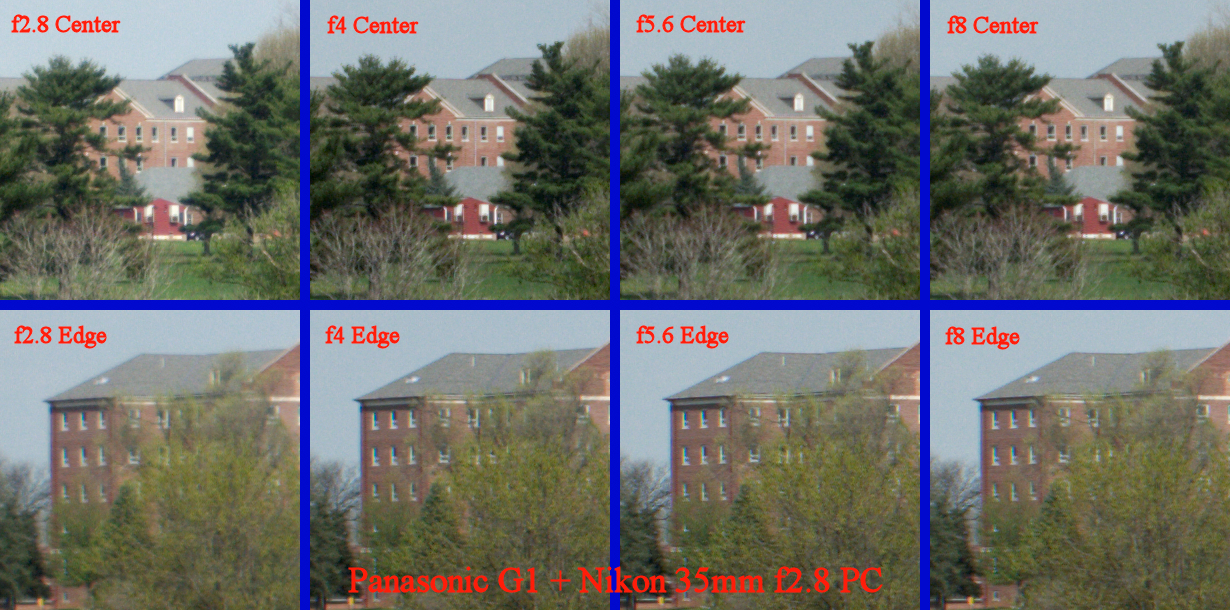
Kettle Run is the first image I have taken with the 35mm PC and the G1. The camera was placed on a small bridge over the stream. Using a normal lens the lower part of the image would not have been visible without tilting the camera, which has an effect on vertical elements like trees. However, with the 35mm PC I could compose the image by turning the shift knob, which is invaluable in a case like this where the camera could not be positioned any lower.

|
Kettle Run 4/25 |
This is the kit lens for the Panasonic G1, which I received when I bought the camera in December, 2010. Like most kit lenses it is quite slow (in terms of aperture), although this lens has a good reputation for image quality. The lens itself retails for $350 at the current time, and I only paid $399 for the camera + lens so it was a good bargain (note that this lens is no longer the kit lens for current G-series cameras--the $200 14-42mm has replaced it, which was a compelling reason to buy the G1 kit with the 14-45mm while it was still available).
The minimum aperture of the 14-45mm @ 35mm is f5, although I chose to shoot at f5.6 instead. In any case, this lens performs well wide open given that it was designed for a digital sensor and it is not fast. The sharpness and contrast are good at f5.6 and there is little, if any, change at f8 (the lighting is different in the f5.6 and f8 images--this is not a result of the change in aperture). Certainly the 14-45mm is a decent, lightweight zoom and offers focal lengths that are difficult to achieve with legacy lenses (legacy wide angle lenses suffer on digital cameras due to the angle of incidence of the light rays). Another plus for the zoom is image stabilization, which increases image sharpness by compensating for camera shake when the camera is not on a tripod.
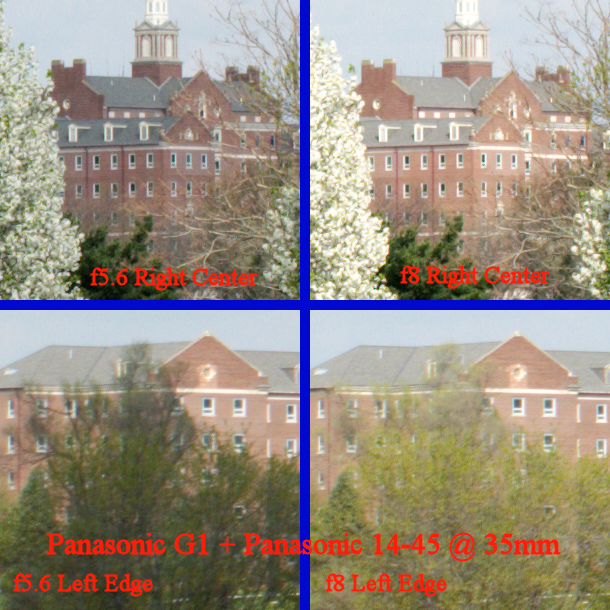
Note: Due to the unexpected results for this lens it was tested again here.
This lens has also been in my collection from the late 1980's, however I did not purchase it new. I biught it used as a fast normal lens, since I had the 28mm and 85mm only at the time. The 50mm does have a couple of "knocks" where the paint is chipped, so the lens may have been dropped (or bumped into something). I believe this happened prior to my buying it, as I do not recall any incidents with this lens, although it is possible I bumped into something which may have caused one of the paint chips (if so it was not a severe impact). In any case, this is reputed to be one of the finer Minolta manual focus lenses but my testing results do not confirm this. My copy of this lens is not sharp at infinity as the images below show, and other indoor tests reveal it is not sharp at minimum focus either. At infinity, f2.3 shows the best sharpness but this then degrades as the lens is further stopped down. Contrast is also best at f2.3, worsens at f3.3, and recovers a bit at f5.6. It may me that my sample is poor due some abuse suffered prior to my buying it. In any case, I will not carry this lens in my bag.
Note: It may appear strange to see f2.3 and f3.3 crops, since these are half-stops in between the "standard" aperture settings. My justification for this is that on MD lenses the first aperture stop after wide open is supposedly a full stop (the next stop after f1.4 on the 50mm of f2) but based on exposure readings on the G1 this is usually not a full stop (usually 2/3 of a stop). The reason for this is the small sensor size of the G1, such that the first stop actually has less impact on the amount of light reaching the sensor as compared to 35mm film. Therefore, I decided to present data for the next half-stop so that the effect of the aperture change is more pronounced.
Note: The image at f1.4 was shot using a B+W neutral density filter due to the 1/4000 maximum shutter speed limitation of the Panasonic G1.
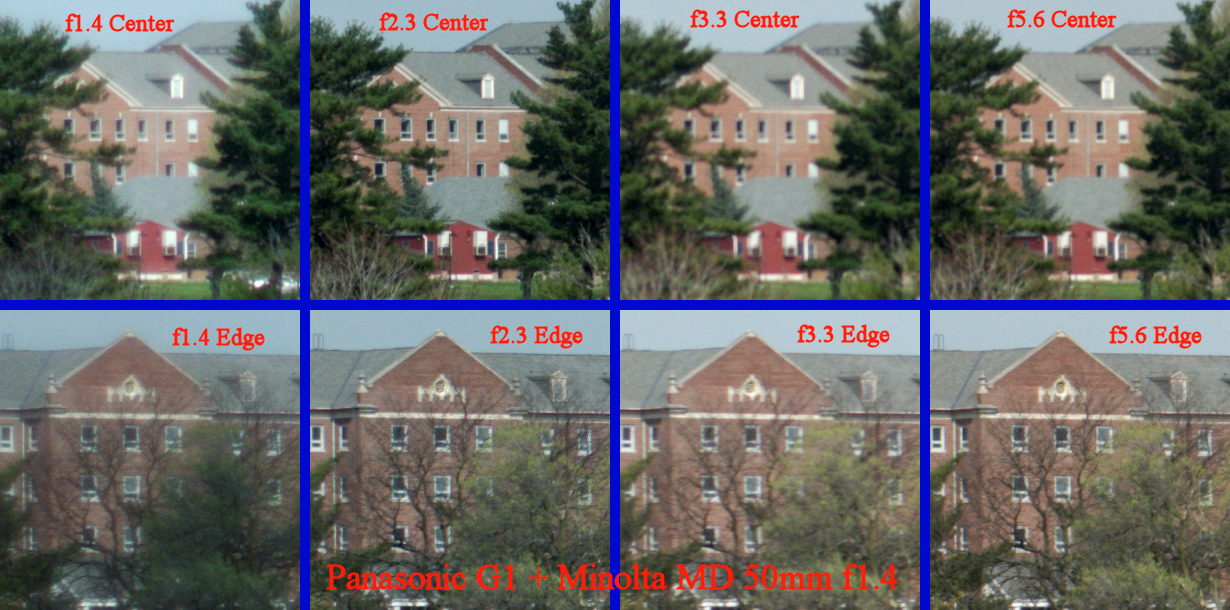
This example image is the first I took with the 50mm. The subject distance was between 1 and 2 meters. When manual focusing wide open there is a significant amount of color fringing which was a cause for concern so I stopped down to between f4 and f5.6, at which point the color fringing was greatly reduced (note that I have shot the lens wide open during indoor testing and I do not see the color fringing in the photograph when the lens is properly focused--just on the LCD when the lens is out-of-focus). The sharpness in the Bough Ice image is acceptable due to downsizing, although viewing the native image at 100% it is obvious that the lens is not "tack sharp."

|
Bough Ice 2/4 |
This is the first lens I purchased for my Minolta X-700 SLR. I bought it and the camera in 1986 to photography Halley's Comet in Aruba. This lens has a very good reputation these days, and commands a price that is probably more than I paid for it in 1986. In this case, the lens does not disappoint. At f2 it is somewhat soft and the contrast is low, but by f3.3 the sharpness has improved and the contrast is much better. At f5.6 the center sharpness and contrast are very good and the edge performance is not far behind. At f8 diffraction seems to be kicking in, as the sharpness and contrast are slightly less but still a decent performance. For now I will keep this lens in my bag, but it will probably be replaced by my next lens purchase. Although the MD 85mm does well at infinity (and probably at portrait distance as well), I often need a lens for 1m distance, and indoor testing reveals that this lens does not perform well near its minimum focus distance of 0.85m.
Note: The image at f2 was shot at 1/3 stop overexposure due to the 1/4000 maximum shutter speed limitation of the Panasonic G1.
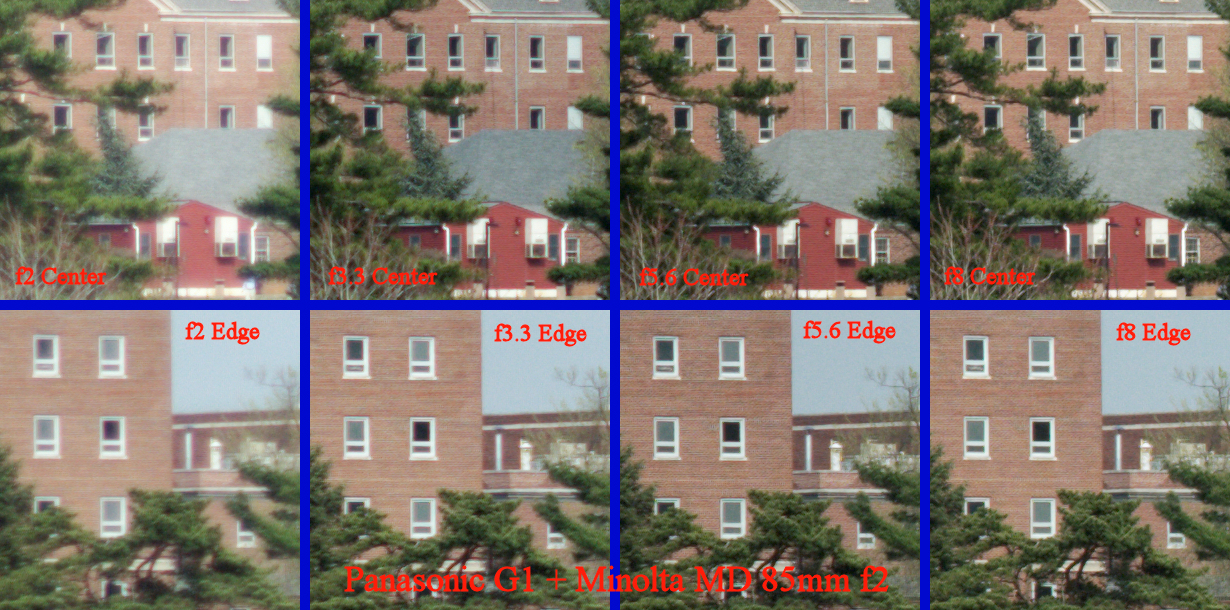
This is my first studio image with the 85mm, shot at between 1 and 2 meters. Although the lens is not tack sharp when photographing test charts at the minimum focus distance, this the lens does quite nicely at here, certainly helped by the downward resizing to web display size.

|
Teasel Combs 2/26 |
I purchased this lens sometime in the 1990's when I wanted something longer than 85mm focal length for some astrophotography I was doing at the time. When I bought it I was lusting after a Minolta MD 135mm f2, but I didn't have much hope of finding one used and I probably couldn't have afforded a new one had it been available at the time (I'm not sure when the 135mm f2 went out of production, but I never saw one in any camera shop I visited). However, I did this used Vivitar 135mm f2.3 in one of my shop visits and the price was quite reasonable. I did not have a high regard for the Vivitar brand at the time, and I had no idea what the "Series 1" designation meant. Nevertheless, I bought the lens on the condition that I could return it after testing. I shot a roll of film and it seemed "okay" so I kept it. Soon thereafter I drifted away from photography for a while and when I returned to the hobby I was shooting mostly sports and the Vivitar never saw any action. When I bought the Panasonic G1 I was excited to test my old Minolta manual focus lenses, but I still assumed the Vivitar was "cheap" and I didn't use it for a while. Then I discovered that the Series 1 Vivitar lenses were something special--for a while Vivitar put in a lot of effort to play the the "big boys" and made some very fine Series 1 lenses. It turns out that the Series 1 135mm f2.3 is something of a find, and I gave it a try on the G1. The Vivitar seemed to do very well for close focus distances and, in fact it was marketed as a "close focus" lens (see below for my first photo with the 135mm: Two Mushrooms). However, I tried it at infinity focus and I was disappointed as it seemed the Minolta MD 85mm outperformed it.
In this test, however, the Vivitar 135mm f2.3 did very well. At f2.3 the right center is soft but the left edge seems better, and both suffer from some loss of contrast. Things improve at f3.3, but by f5.6 the lens is really starting to shine. The left edge still seems a but sharper than the center which may indicate some decentering of a lens element or a curved focal plane, but the results are still pretty good. Diffraction is beginning at f8, but the lens is resolving well for the 1/4 mile distance. I am not sure why this lens seemed to do less well in a previous infinity focus test, although I may have just made a focusing error at the time. However, this lens is definitely a keeper, although it is quite heavy so I may look for something lighter for long hikes. The real plus is the close focus capability which I find very useful in the field.
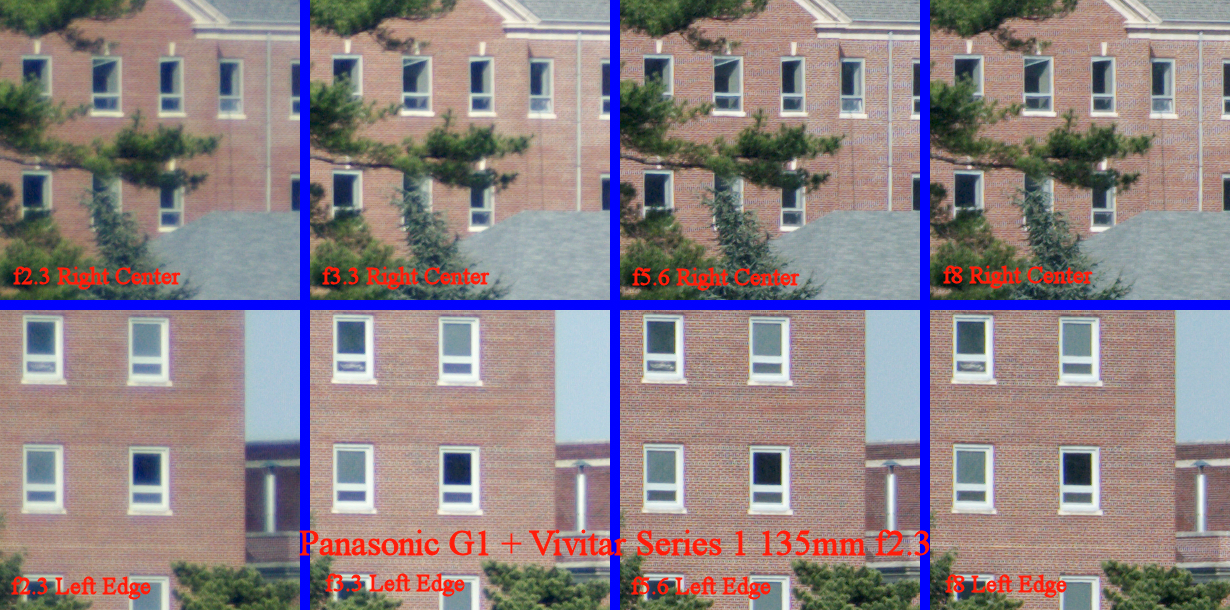
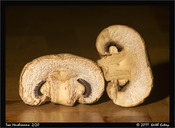
|
Two Mushrooms 2/20 |
In general, I feel teleconverters are a last resort when more focal length is needed, as the quality tends to be inferior to a lens with a native focal length equal to that of a shorter lens plus the teleconverter. However, sometimes getting the shot is all that matters and I did purchase a newMinolta 2x teleconverter in the late 1980's, primarily for use with my Minolta MD 70-210 f4 zoom. In this case, I was curious as to how the teleconverter + the MD 85mm would perform. The results are not that bad at the f4 setting on the lens (actually f8 due to the focal length multiplication of the teleconverter). The resolution is decent, perhaps even giving the Vivitar 135mm a challenge, although there is some magenta color fringing in high contrast areas (this can be corrected by software). By f5.6 on the lens (f11 in actuality) diffraction is degrading the resolution although the color fringing is somewhat less. This test was something done mostly for amusement, since I don't plan to ever use this combination of lenses in the field. The Vivitar 135mm is a bit shorter in focal length but has better quality so I would prefer that lens over the 85mm + teleconverter. However, if I'm ever in a situation where I absolutely need a lens approaching 300mm I could try the Vivitar 135mm with the teleconverter since the teleconverter is very light (I have a Minolta MC 300mm f4.5 but it is very heavy and I would not normally carry it on a hike).
